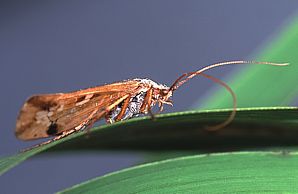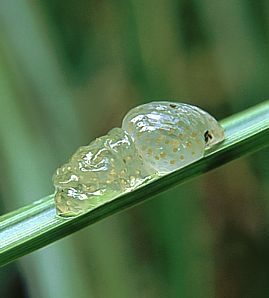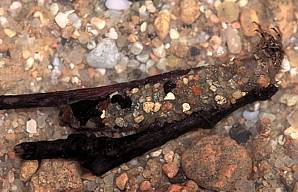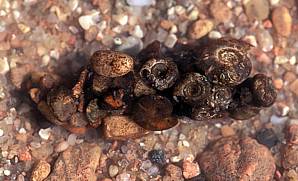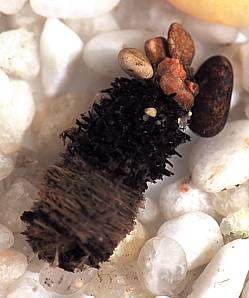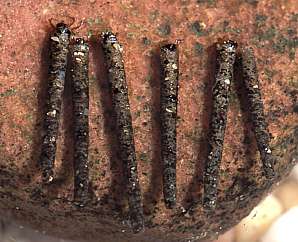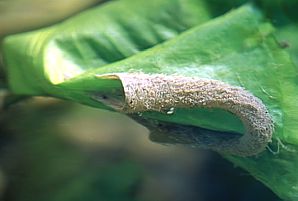|
AQUATIC INSECTS
|
||||||||||||||
Text:
|
Caddisflies
CADDISFLIES Trichoptera are the insects resembling butterflies which are near relatives to them. There are about 10 thousand species of Trichoptera; over 900 of them are known in Europe and about 260 in Poland. Almost all larvae of national species of Trichoptera live in different types of fresh waters and only some of them can be met inland - in the layer of mosses and mouldering forest bed.
Adult insects are different from butterflies because they lack suckers and little hulls covering the wings (Trichoptera's wings have chitin hair only). In the resting position the wings are folded like a tile on the abdomen. Their color is inconspicuous as it is usually grey, black, or brown - they hardly have red or yellow drawing. Their feelers are long (often even longer than the whole body) and consist of several segments; in the resting position they are put forward. They are mostly active at night and at dusk; in the daytime they can be found in the hidden places in the vicinity of water. They are poor aviators. They eat the nectar of flowers which is taken by means of licking-sucking mouth opening. The copulation takes place at the beginning of June to the end of August. The female lays eggs in packs covered with the jelly-like substance directly to the water or on the plants inclining over water. The eggs' development lasts from 2 to 4 weeks. Some individuals live inland just about 8 days. The most important moment in their lives is a mating flight, which occurs for most of our native species at the beginning of June to the end of August.
As far as body construction is concerned Trichoptera larvae can be divided into two groups: the caterpillar-like larvae whose longitudinal axis of the head forms a right angle with the axis of the body and the campodeal larvae whose longitudinal axis of the head and body forms approximately a straight line.
Caterpillar-like larvae live in the cases which are left only in special circumstances. The skeleton of the case is a tube woven from the silken follicle produced by the spinning gland. Then, depending on the species, larva builds the tube around with different materials such as: pieces of reed, living and dead fragments of leaves of water plants, spruce needles, seeds, the shells of crustaceans and the shells of mollusks, twigs, the grains of sand and little stones . Such a case protects larva's soft abdomen and as the larva grows on the case is enlarged respectively. The case is built with the help of larva's mouth opening and frontal limbs.
Larvae of Trichoptera living in the stagnant waters build lighter cases usually made from different parts of plants, however in the flowing waters they build their cases using heavier materials such as little stones and shells. Sometimes the cases possess their own „anchors" made from little stones attached to the back of the case so that larva was not snatched by the rapid current of the stream. Larva of the same species can, depending on the place of occurrence and time of year, uses other materials to build the case. If so it is not their characteristic specific feature then. Larva transfers the case with the help of dorsal growth on the first segment of abdomen and the hooked additions on the last segment. All caterpillar-like larvae eat plants - both algae as well as higher plants and also the dead fragments of plants (detritus). They breathe by means of gills-trachea organ which is placed on the back, sides of the body or on the chest; they seldom breathe using the whole body surface.
The campodeal larvae seldom build their cases. They usually live in the flowing waters or lakes of strong waving. Many of them lead a predacious lifestyle hunting for different kinds of little water organisms. They use the net-like follicles to hunt - hunting nets which are hung among water plants water or on the stones. The follicles have different shapes: from flat cornets to the funnels with oblong bags whose inflow openings are always directed upstream. The larva of Trichoptera is on the watch inside of such a trap waiting for the food which is brought to the nets by the current of water.
After the period of growth the larvae of Trichoptera prepare themselves for a metamorphosis. Both types of larvae, living in the case or not, build their chrysalis case. Larvae living in the case close their little houses with special lids, leaving only a small opening for the flow of water. After more or less 2-3 weeks the chrysalis leaves the case. It is different from adult insect because the wings are not fully developed which are, while in the resting position, called wing flank sheaths. The chrysalis wanders to the water surface where it is transformed into an adult Trichoptera. Most of them have a one-year life cycle, some however can have longer cycles, two or three-year cycle, others can produce two generations a year.
There are 23 species of Trichoptera living in the area of Wigry National Park; 15 of them build the cases. Two species - Oligoplectrum maculatum and Leptocerus interruptus are in danger of extinction and were placed into the „The red list of of animals which are dying or are in danger of extinction. Both these species used to live in Wigry lake in the 20's of the 20th century. Oligoplectrum maculatum was not observed here anymore and Leptocerus interruptus still lives in Wigry lake.
These are the species of Trichoptera living on the waters of Wigry National Park:
Net-making and free-living caddisflies
Case-making caddisflies
|
|||||||||||||
|
|
|
